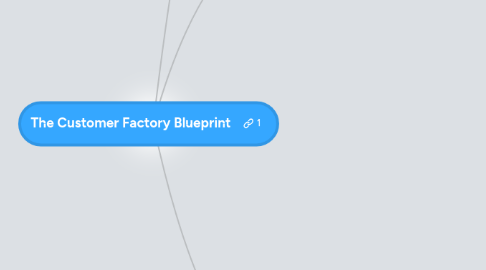
1. Model Your Business as a System
1.1. Systems vs Goals
1.1.1. Repeatability is Key
1.1.2. Staged Rollout
1.1.3. Theory of Constraints
1.2. Deconstruct your idea
1.2.1. Vision (WHY)
1.2.1.1. 1-Page Business Model vs Business Plan
1.2.1.1.1. Lean Canvas
1.2.2. Strategy (HOW)
1.2.2.1. The Customer Factory
1.2.2.2. Systematic De-risking of Business Model
1.2.2.2.1. 10x Rollout
1.2.2.2.2. Staged Milestones Drives Strategy
1.2.3. Product (WHAT)
1.2.3.1. Your Solution is NOT the product
1.2.3.2. Your Solution is Part of Machinery to Create a Happy Customer
1.2.3.3. Staged Strategy will Uncover the Right Product
1.3. Model Staged Milestones
1.3.1. Top-down Modeling
1.3.2. Bottoms-up Modeling
1.3.3. Analogs/Antilogs
2. Baseline Current Throughput
2.1. Identify Your Current Stage
2.1.1. Your Stage Drives Your Strategy
2.1.2. You Can Jump in at any Stage
2.2. Establish a Standard Measure of Progress
2.2.1. Innovation Accounting
2.2.2. Map Customer Factory to User Actions
2.3. Measure everything as a cohort
2.3.1. Concept of Batch Based Production
2.3.2. Time-based Cohorts
2.3.3. The Groundhog Day effect
2.4. Experiment Like a Scientist
2.4.1. Build Models Before Experiments
2.4.2. Good Experiment Design
2.4.2.1. Experiments are Additive
2.4.2.2. Declare Outcomes Upfront
2.4.2.3. Falsifiability
2.4.2.4. Time-boxing
2.4.2.5. Dealing With Failure
2.4.2.5.1. Pivots
2.4.2.5.2. Root-cause Analysis
2.5. Establish a Regular Reporting Cadence
2.5.1. External Accountability
2.5.1.1. Daily Standups
2.5.1.1.1. Tasks
2.5.1.2. Weekly Standups
2.5.1.2.1. Experiments
2.5.1.3. Monthly Standups
2.5.1.3.1. Milestones
2.5.2. Lean Stack
2.5.2.1. Lean Canvas
2.5.2.2. Lean Dashboard
2.5.2.3. Experiment Reports
3. Increase Throughput in Stages
3.1. Problem/Solution Fit
3.1.1. Goal
3.1.1.1. Key Objective
3.1.1.1.1. Validate Customer Pull
3.1.1.2. Success Metric
3.1.1.2.1. Achieve X Customer Production Rate by Y Time Frame
3.1.2. How
3.1.2.1. Create a Compelling Offer
3.1.2.1.1. Mafia Offer
3.1.2.1.2. Smoke Test Offer
3.1.2.1.3. Preorder Offer
3.1.2.1.4. Free Cookie Offer
3.1.3. Tactics
3.1.3.1. Understand Customer/Problem
3.1.3.1.1. Problem interviews
3.1.3.1.2. Observation
3.1.3.1.3. Psychology
3.1.3.1.4. Personas
3.1.3.1.5. Current Reality Workflow
3.1.3.2. Build Offer
3.1.3.2.1. Define Solution
3.1.3.2.2. Build Demo
3.1.3.2.3. Set Pricing
3.1.3.3. Deliver Offer
3.1.3.3.1. Solution Interviews
3.1.3.3.2. Landing Pages
3.1.3.3.3. AIDA
3.1.3.3.4. Psychology
3.2. Product/Market Fit
3.2.1. Goal
3.2.1.1. Key Objective
3.2.1.1.1. Validate Business Model at Small Scale
3.2.1.2. Success Metric
3.2.1.2.1. Achieve 10X Customer Production Rate by Y Time frame
3.2.2. How
3.2.2.1. Deliver (and Capture) Customer Value Using MVP
3.2.3. Tactics
3.2.3.1. Build MVP
3.2.3.2. Instrument for Learning
3.2.3.3. Metrics
3.2.3.3.1. Activation
3.2.3.3.2. Retention
3.2.3.4. Customer Journey Mapping
3.2.3.4.1. Onboarding/Activation
3.2.3.4.2. Customer WOW experiences
3.2.3.5. Lifecycle Messaging
3.2.3.5.1. Scale Relationship Building
3.2.3.5.2. Reward Positive Customer Actions
3.2.3.5.3. Learn from Neagtive Customer Actions
3.2.3.6. MVP Evolution
3.2.3.6.1. Rinse and Repeat Process
3.2.3.6.2. Feature Prioritization
3.2.3.6.3. Customer Interviews
3.2.3.6.4. Release Level Cohorts
3.2.3.6.5. Feature Flags
3.2.3.6.6. Split-testing
3.2.3.6.7. Continuous Deployment
3.2.3.6.8. Kill Features
3.2.3.6.9. Pricing Evolution
3.3. Scale
3.3.1. Goal
3.3.1.1. Key Objective
3.3.1.1.1. Accelerate Business Model to Full Potential
3.3.1.2. Success Metric
3.3.1.2.1. Achieve 100X Customer Production Rate by Y'' Time frame
3.3.2. How
3.3.2.1. Identify and Tune Engines of Growth
3.3.2.1.1. Paid
3.3.2.1.2. Sticky
3.3.2.1.3. Viral
3.3.3. Tactics
3.3.3.1. Metrics
3.3.3.1.1. Acquisition
3.3.3.1.2. Retention
3.3.3.1.3. Referral
3.3.3.2. Customer Segmentation
3.3.3.2.1. Source Level Cohorts
3.3.3.2.2. CHI
3.3.3.2.3. Qualitative Polling
3.3.3.3. Lifecycle Messaging
3.3.3.4. Acquisition Channel Testing
3.3.3.5. Upsells and Cross-sells
3.3.3.6. Referal Campaigns
3.3.3.7. Establish Key Partners
